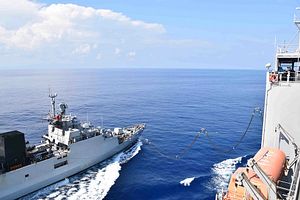India’s Chief of Defence Staff General Bipin Rawat announced last month that India will prioritize submarines over its third aircraft carrier. The importance of this announcement was lost amid the clutter surrounding U.S. President Donald Trump’s visit to India. “When we know that there would be two aircraft carriers there, and if the submarine force is dwindling, then our priority should be for submarines,” said General Rawat. It is a notable statement coming from the CDS himself, possibly hinting at the much-needed change of approach from sea control to sea denial towards the Indian Ocean Region (IOR).
The Indian Navy believes in a strategy of sea-control, meaning “the ability to use the sea in reasonable safety.” The Indian naval doctrine defines sea control as a capability to use a defined sea area, for a defined period, for a defined purpose, and simultaneously deny the sea to the enemy. The document itself says that any control per force would be limited to space and time, and doesn’t guarantee protection from an enemy attack. Sea control is exercised using a combination of capital-intensive ships, fixed-wing aircraft, helicopters and amphibious capabilities. It is an expensive affair and requires sustained modernization.
In contrast, a sea denial strategy means denying the adversary use of a sea area for a certain duration. It is a part of sea control and could be used offensively to lower adversary’s war-waging capabilities by limiting its freedom to navigate. Submarines combined with surface ships, helicopters and surface-to-surface missiles are optimal tools for exercising sea denial.
China’s Rise
China’s 2015 defense white paper called for a change of approach from near seas defense to far seas protection. China is dependent on the Sea Lanes of Communications (SLOC) for its energy imports and trade flow which passes through the IOR. Hence, the securing IOR features prominently in its China’s core objectives. To protect its interest overseas, it is already commissioning more long-ranged vessels and strategic aircraft. It established an oversea military outpost at Djibouti in 2017. More such outposts could emerge in Pakistan, Cambodia and Myanmar in the future. China and Pakistan have recently conducted the sixth edition of ‘the Sea Guardians’ naval exercises in the Arabian Sea in January 2020.
In December 2019, the Chinese research ship, Shiyan-1, was caught operating in the waters around Port Blair until the Indian navy expelled it. Naval exercises and the research activities are means to familiarize the navies with the oceanic geographies. Beijing’s heightened presence, even during peacetime, may prompt some countries that had been friendly toward New Delhi to shift their allegiances. China’s increasing economic and military collaborations and activities across the ocean have made this region a hotbed of geopolitical competition. India’s interests are directly impacted by China’s naval modernization and its increasing footprints in the IOR.
India Needs to Priorities
India’s naval modernization has taken a back seat due to shrinking defense budgets. The Navy’s share in the budget declined from 18 per cent in 2012 to 13 per cent in 2019-20. Due to the fund crunch, the requirement of 200 ships has been brought down to 175. There is an apparent mismatch between its ambitions to control the sea and its current capital expenditure. The lack of funds means that India is also underutilizing its strategic tri-service base at Andaman and Nicobar Islands, which overlooks the all-important Malacca Strait.
It is crucial that the navy priorities its acquisition based on the risk assessment of the region. Given the limited funds for modernization, it at least needs to develop sea denying capabilities, which is cost-efficient than developing sea-controlling capabilities. Submarines are one of the most essential tools for sea denial. They are the means to harrying and tiring the enemy. Their stealth capabilities make them hard to detect in the open seas. Currently, India only has 17 submarines located at Mumbai, Visakhapatnam, Kochi, and Port Blair. Looking ahead, it needs to use this opportunity to develop more sea denial tools and underwater stealth vehicles. The CDS’s statement should be a good starting point to put India’s submarine modernization plans back on track, acquiring more surveillance aircraft and speeding up the process of acquiring multirole choppers for developing sea denying capabilities.
Suyash Desai is a research analyst focusing on China at the Takshashila Institution.

































